Rule Interpretations
When four-in causes a penalty shot
If, in the last two minutes of regulation time (or at any time during overtime), a player deliberately skates into their defending zone - causing a four-in situation; and then proceeds to get involved in the play while there are still four skaters in the zone - a Penalty Shot is awarded to the other team.
When the team with the penalty gets the freepass
From time to time, an On-Ice Official will be giving the signal for a delayed penalty when the non-offending team will cause a violation - such as carrying the ring over the blueline or violating the crease. As a result - play will be stopped immediately and the On-ice Official will call the delayed penalty. However, play stopped because of the violation - and not because of the penalty, and the team that received the penalty will also get the freepass after the stoppage in play.
You can play 3 in when you're short
Offensively...
When your team is serving more than 1 penalty, the rules require that at least 1 skater remain outside of your defending zone restricted area.
However, when you are in your attacking zone, attempting to score a goal - you may have all 3 skaters enter that zone.
Delaying the call on four-in
The four-in call often leads to confusion on the ice. This is because the rules do not require that play be stopped when four-in occurs until the team with four-in gains control of the ring.
The procedure that On-ice Officials are to follow on a four-in situation is:
- If the team in control of the ring skates four-in, make the call immediately.
- Otherwise, raise a bent arm to signal a delayed violation.
- If the 4th player leaves the zone before their team gains control - begin a five second count.
- If the ring leaves the zone before the team gains control - no call will be made.
- If the team gains control in the zone within the five second count - make the call.
- If the team gains control while there are still four-in, a delayed penalty should be called.
Next time, before you start yelling four-in: check the signal being given by the On-ice Official nearest the freeplay line.
Goal-crease violations
Only the goalkeeper or the acting goalkeeper (AGK) may legally play any ring that is on the goal crease line or entirely inside the goal crease. Alternately, neither the goalkeeper nor the AGK may move a ring into or onto the goal crease when it is entirely outside of the goal crease.
If either of these rules are broken, play is stopped and the ring is given to the non-offending team.
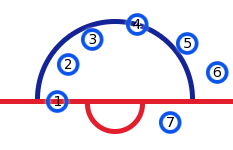
In the above image rings 1-5 may only be played by the goalkeeper. Rings 6 and 7 may be played by any player, but the goalkeeper may not bring the ring inside the crease.
When a goal is not a goal*
If the ring contacts or enters the goal crease while the shooter's stick is in the ring and the ring subsequently crosses the goal line - the goal is not counted; because a crease violation has occurred.
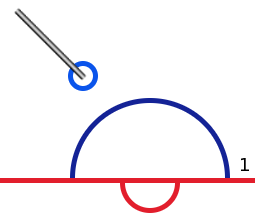
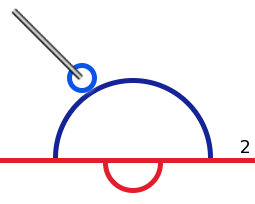
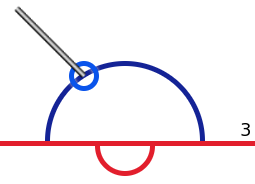
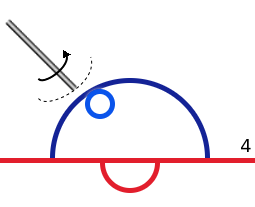
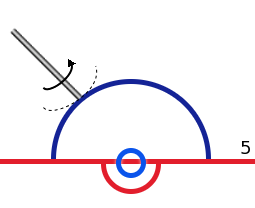
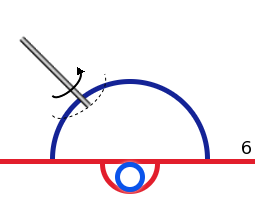
In the above examples - only 1, 4, 5 and 6 are LEGAL shots on goal.
* Other situations can cause a goal to be nullified. Please see the Ringette Canada Official Rules 10.3 A goal is nullified...
Play the ring! Sticks down!
When an On-Ice Official is yelling "Play the ring" or "Sticks down" it is usually because there is an infraction occurring that is illegal, but has not yet caused a material change in advantage - and therefore there is no penalty to be called yet. (see The First Principle of Officiating).
Often this is due to using your body or stick to interfere on a play, or due to over enthusiastic checking that is getting too high - up near the hands, etc.
When you hear an Official calling these phrases out, consider what you're doing and pull back if you think you're at fault. If a material change of advantage does occur - you're likely to get a penalty.
The blueline is neutral
"A ring on or touching the blue line is simultaneously in both of the zones bounded by that line and is playable by all eligible players."
When the ring is on or touching the blue line, nearly any player may play the ring and carry it into either zone. The player who last touched the ring may only carry the ring back into the zone where they last touched it, or they can tap the ring to pass it into the other zone.
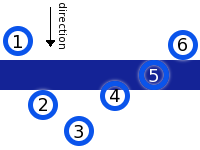
In the image above, the player who last touched the ring may only shoot or pass rings 1,2,4,5 or 6 into the next zone. They may not play ring 3. Any other player may carry rings 2,4,5 & 6 into either zone, and can play rings 1 & 3 normally.
The first principle of officiating
"The purpose of the playing rules is to penalize a player who, by reason of an illegal act, has placed an opponent at a disadvantage."
This principle is the fundamental rule of Officiating. Every penalty decision made by an an On-Ice-Official (whether to call, or not to call) is judged on whether there has been both: an illegal infraction as per the rule book, and a material change in advantage to one team.
The purpose of this principle is to ensure that the game progresses smoothly and so that it is not unnecessarily interrupted by the official's whistle.

